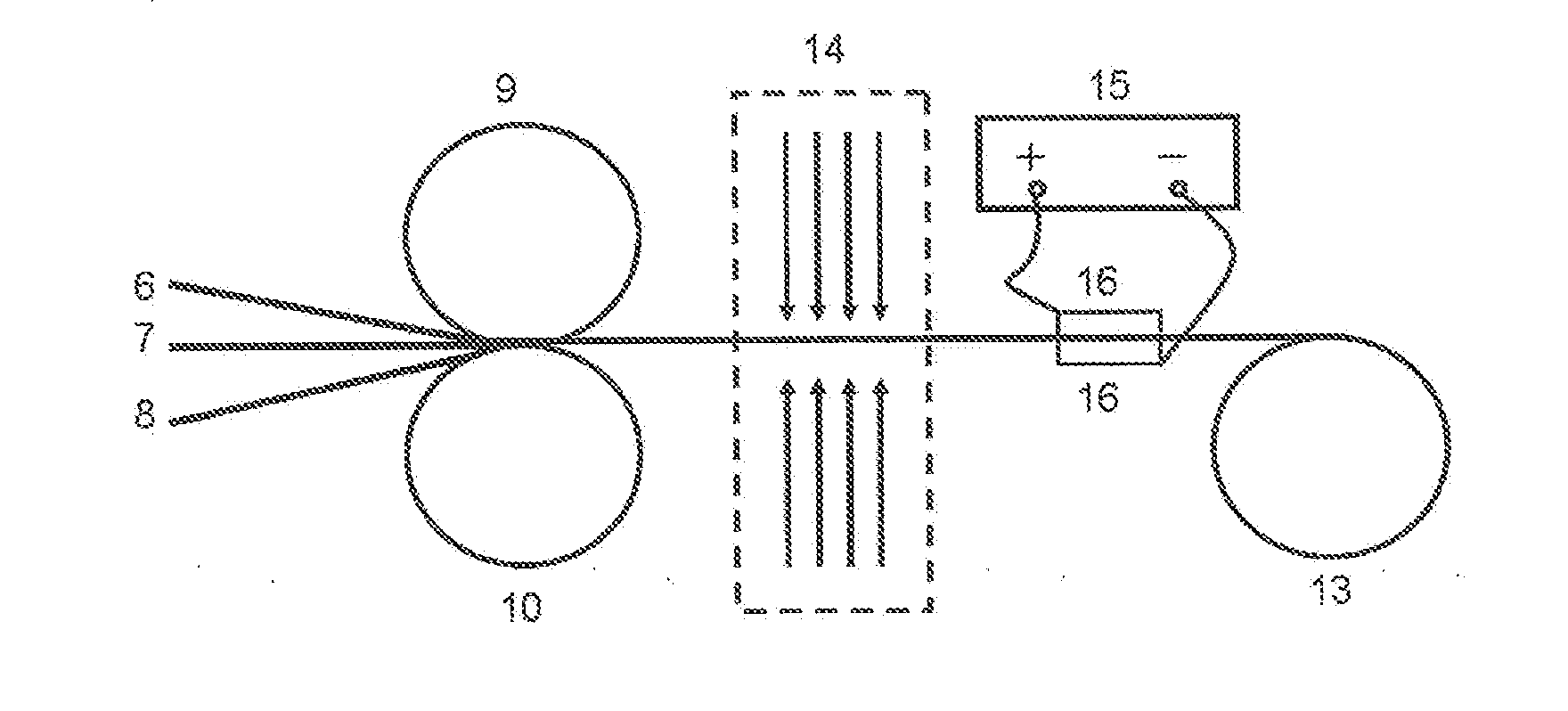Continuous production process for polytetrafluoroethylene functional film for electro-mechanical energy conversion
a production process and functional film technology, applied in the field of continuous production process of electromechanical energy conversion films made from polytetrafluoroethylene, can solve the problems of no report on thermally stable piezoelectrets in large scale produced by continuous production lines, sharp decay or even complete disappearance of piezoelectric effect in pp piezoelectrets, etc., to achieve excellent piezoelectric effect, improve thermal stability, and high production efficiency
- Summary
- Abstract
- Description
- Claims
- Application Information
AI Technical Summary
Benefits of technology
Problems solved by technology
Method used
Image
Examples
example 1
[0023]FIG. 1 shows the microstructure and charge distribution of a piezoelectret involved in the present invent, and the schematic view of the piezoelectric effect in such material. A continuous production process for fabricating the electromechanical energy conversion functional films based on PTFE consists of two steps of a thermally bonding of layer stacks with void structure and an electrical polarization.
[0024]The steps for the thermal bonding of the laminated films with void structure are as followings. A porous PTFE layer with a thickness of 5 μm (7) is sandwiched by two 5 μm thick compact PTFE layers (6 and 8). And then the stacks of layers are fed into a pair of heated press rollers (9, 10) and thermally bonded by them. The diameters of the heated press rollers are 150 mm. The surfaces of the heated press rollers are with cross patterns. The temperatures of the heated press rollers are set at 150° C. The pressure of the rollers applying on the film system is 1 MPa. The spee...
example 2
[0029]Set an electrode coating system (14) and a contact charging system (15,16) between a pair of heated press rollers (9,10) and the wind up roller (13).
[0030]A continuous production process for fabricating the electromechanical energy conversion functional films based on PTFE consists of two steps of a thermal bonding of layer stacks with void structure and an electrical polarization.
[0031]The steps for the thermal bonding of the laminated films with void structure are as followings. A porous PTFE layer with a thickness of 400 μm is sandwiched by two 20 μm thick compact PTFE layers. And then the stacks of layers are fed into a pair of heated press rollers (9, 10) and thermally bonded by them. The diameters of the heated press rollers are 150 mm. The surfaces of the heated press rollers are with cross patterns. The temperatures of the heated press rollers are set at 420° C. The pressure of the rollers applying on the film system is 200 MPa. The speed of the film system between the...
example 3
[0035]A porous PTFE layer with a thickness of 2 μm (7) is sandwiched by two 50 μm thick compact PTFE layers (6 and 8). And then the stacks of layers are fed into a pair of heated press rollers (9, 10) and thermally bonded by them. The diameters of the heated press rollers are 150 mm. The surfaces of the heated press rollers are with cross patterns. The temperatures of the heated press rollers are set at 150° C. The pressure of the rollers applying on the film system is 200 MPa. The speed of the film system between the two rollers is 10 m / min. After the hot pressing, a laminated PTFE film with micro porous structure is obtained.
[0036]FIG. 2 shows the schematics of the process for fabricating PTFE piezoelectret films by using corona charging. The corona charging for a laminated PTFE film is performed by feeding the laminated PTFE film into the corona charging area formed by electrode rollers 11 and 12. The corona voltage is 20 kV. The distance between the electrode roller (12) and cor...
PUM
| Property | Measurement | Unit |
|---|---|---|
| thickness | aaaaa | aaaaa |
| thickness | aaaaa | aaaaa |
| thickness | aaaaa | aaaaa |
Abstract
Description
Claims
Application Information
 Login to View More
Login to View More - R&D
- Intellectual Property
- Life Sciences
- Materials
- Tech Scout
- Unparalleled Data Quality
- Higher Quality Content
- 60% Fewer Hallucinations
Browse by: Latest US Patents, China's latest patents, Technical Efficacy Thesaurus, Application Domain, Technology Topic, Popular Technical Reports.
© 2025 PatSnap. All rights reserved.Legal|Privacy policy|Modern Slavery Act Transparency Statement|Sitemap|About US| Contact US: help@patsnap.com



